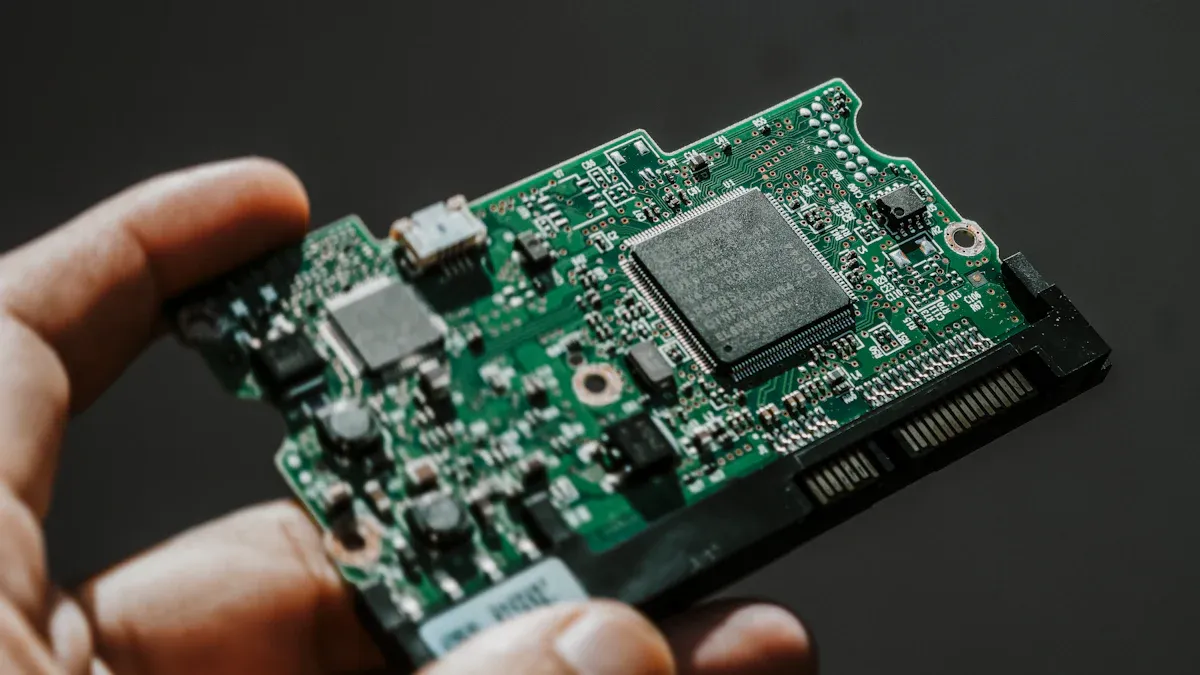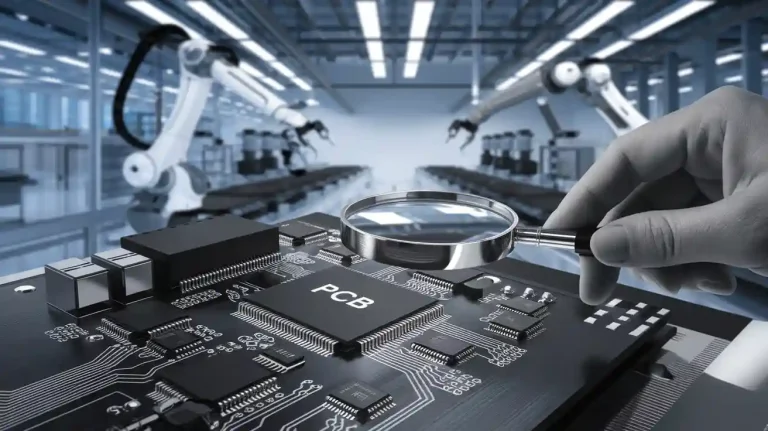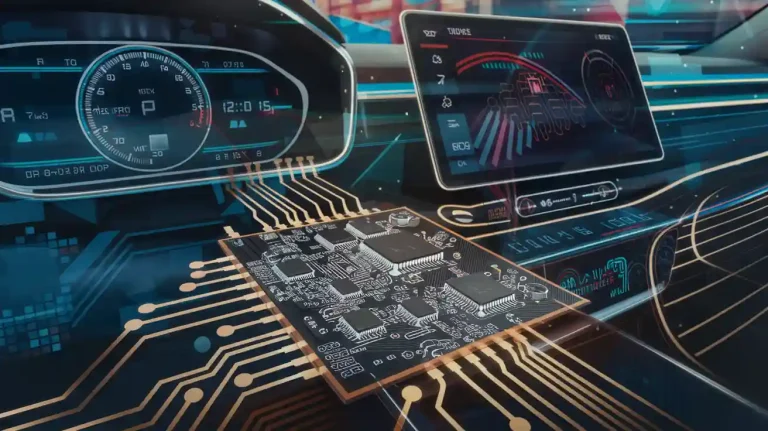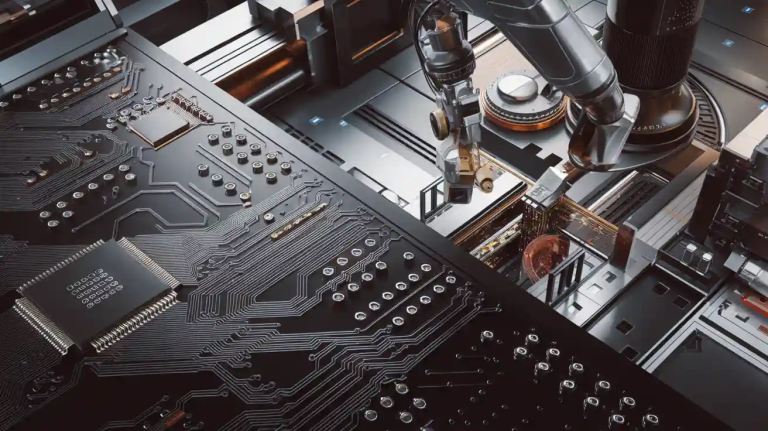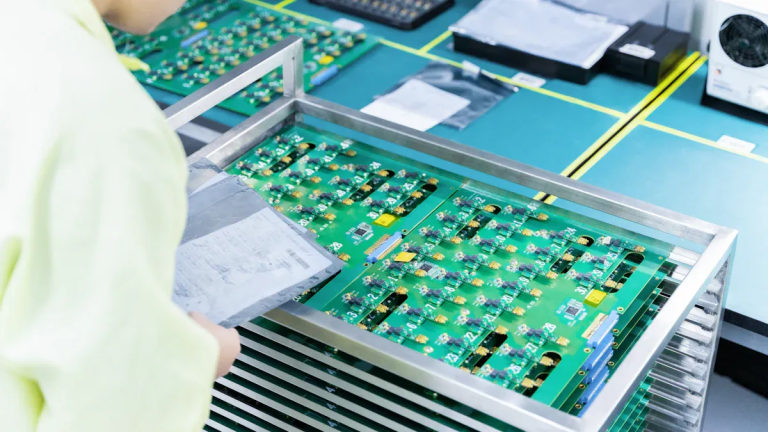Automotive PCBs, or car PCBs, play a critical role in modern vehicles. They ensure your car operates efficiently and safely by integrating advanced technologies into compact designs. For example:
- The rise of automotive electronics stems from the adoption of systems like ADAS and autonomous driving.
- These systems rely on car PCBs to handle data from multiple sensors.
- High-layer car PCBs pack more components into smaller spaces, essential for today’s vehicles.
Their durability, heat resistance, and lightweight construction make car PCBs indispensable for managing complex automotive functions.
Key Takeaways
- Car PCBs help keep vehicles safe and working well. They support systems like ADAS and engine controls.
- Strong and heat-resistant PCBs work reliably in tough car conditions.
- Small and light PCBs improve how cars run and save fuel. This is extra helpful for electric cars.
- Custom-made PCBs are designed to fit specific needs, making systems work better.
- Good electrical performance and strict testing make sure PCBs work safely for you and your passengers.
Key Features of Car PCBs
Durability and Mechanical Strength
Car PCBs are designed to endure the harsh conditions of automotive environments. You rely on these printed circuit boards to withstand vibrations, shocks, and extreme temperatures. Their robust construction ensures that electronic components remain securely mounted, even in challenging driving conditions. Manufacturers often use materials like FR4 and metal-core substrates to enhance mechanical strength. These materials provide the rigidity needed to prevent damage during operation.
The durability of automotive printed circuit boards directly contributes to the reliability of safety features in modern vehicles. For instance, systems like airbags and anti-lock braking depend on PCBs that can perform consistently under stress. By choosing durable PCBs, you ensure the longevity and safety of your vehicle’s electronic systems.
Heat Resistance and Thermal Management
Automotive PCBs must handle significant heat generated by electronic components. Without proper thermal management, overheating could lead to system failures. To address this, manufacturers incorporate heat-resistant materials and advanced thermal designs. For example, metal-core PCBs are commonly used in high-power applications like engine control units. These PCBs efficiently dissipate heat, ensuring stable performance.
You benefit from these features in systems like infotainment and battery management, where heat resistance is critical. Effective thermal management not only enhances performance but also extends the lifespan of the PCB. This makes it a vital feature for modern automotive applications.
Compact and Lightweight Design
The compact and lightweight design of car PCBs plays a crucial role in modern vehicle engineering. High-Density Interconnect (HDI) PCBs are a prime example of this innovation. These PCBs allow for higher connection pad density, reducing the overall size and weight of automotive systems. Components can be mounted on both sides of the PCB, maximizing functionality while minimizing space usage.
| Feature | Description |
|---|---|
| Small size | HDI PCBs have a compact size that allows for efficient use of space in automotive applications. |
| Low weight | The lightweight nature of HDI PCBs contributes to overall vehicle weight reduction. |
| Component mounting | Components can be mounted on both sides, enhancing functionality while minimizing space usage. |
This design benefits you by improving vehicle performance and fuel efficiency. A lighter vehicle consumes less energy, which is especially important in electric vehicles. Additionally, the compact size of these PCBs enables the integration of advanced features like infotainment systems and safety features without compromising space.
High Electrical Performance and Reliability
Automotive printed circuit boards must deliver exceptional electrical performance to support the demanding requirements of modern vehicles. You rely on these PCBs to ensure consistent signal transmission, minimal power loss, and reliable operation under varying conditions. Manufacturers achieve this by using advanced materials, precise manufacturing techniques, and rigorous testing protocols.
To validate the high electrical performance of car PCBs, manufacturers employ several monitoring methods and benchmarks. These metrics ensure that the PCBs meet stringent industry standards for reliability and functionality.
| Monitoring Method | Parameter Measured | Acceptance Criteria |
|---|---|---|
| Laser-Induced Acoustic | Hole Completion | Frequency Shift >120kHz |
| Backside CCD | Exit Hole Diameter | 105-115% Entry Diameter |
| Gas Chromatography | Ablation Byproducts | CO2 Levels <200ppm |
| X-Ray Inspection | Plating Uniformity | Copper Thickness ≥18µm |
| Thermal Shock Testing | Via Reliability | 500 Cycles (-40°C/+125°C) |
These benchmarks highlight the precision and reliability of automotive PCBs. For example, thermal shock testing ensures that vias remain intact after repeated exposure to extreme temperatures. This reliability is critical for systems like engine control units and safety features, where failure is not an option.
By meeting these performance standards, car PCBs enable seamless operation of electronic components in your vehicle. Whether it’s powering infotainment systems or managing battery performance, these PCBs ensure that your vehicle operates efficiently and safely.
Customization for Automotive Applications
Customization is a cornerstone of automotive PCB design. You benefit from tailored solutions that meet the specific needs of your vehicle’s electronic systems. Manufacturers offer a range of customization options, from mixed assembly techniques to specialized layouts for high-density interconnect (HDI) PCBs.
- Mixed assembly techniques allow manufacturers to combine surface-mount and through-hole components. This approach creates compact and high-performance PCBs, ideal for modern vehicles.
- eCockpit solutions provide tailored services like Software Stack Development and HMI Design. These features enhance user experience and integrate seamlessly into automotive applications.
- Silkbridge specializes in custom HDI PCB boards, offering expertise in layout and manufacturing. Their designs optimize space and functionality, ensuring that your vehicle’s electronic components perform at their best.
Customization ensures that automotive PCBs align with the unique requirements of your vehicle. For instance, battery management systems in electric vehicles demand precise thermal management and compact designs. By leveraging customized PCBs, manufacturers deliver solutions that enhance performance and reliability.
This adaptability extends to safety features as well. Airbag deployment systems and anti-lock braking rely on PCBs designed for rapid response and consistent operation. Customization ensures that these critical systems function flawlessly, safeguarding you and your passengers.
Automotive Applications of PCBs
Engine Control Units (ECUs)
Engine Control Units (ECUs) are the brain of your vehicle’s engine management system. These systems rely heavily on automotive printed circuit boards to process data from various sensors and control actuators. You benefit from ECUs that optimize fuel injection, ignition timing, and emission control, ensuring your vehicle operates efficiently and meets environmental standards.
The PCBs in ECUs must handle high-speed data processing and withstand harsh conditions like extreme temperatures and vibrations. Manufacturers use advanced materials and designs to ensure these PCBs deliver reliable performance. For example, metal-core PCBs are often used to manage the heat generated by high-power electronic components. This ensures the ECU remains functional even under demanding conditions.
By integrating car PCBs into ECUs, manufacturers enable precise engine control, improving fuel efficiency and reducing emissions. This technology plays a critical role in modern automotive applications, ensuring your vehicle meets performance and regulatory requirements.
Advanced Driver-Assistance Systems (ADAS)
Advanced driver-assistance systems (ADAS) enhance your safety by providing features like lane-keeping assistance, adaptive cruise control, and automatic emergency braking. These systems depend on automotive electronics that process data from cameras, radar, and ultrasonic sensors. Automotive printed circuit boards serve as the backbone of these systems, ensuring seamless communication between sensors and control units.
You rely on ADAS to make split-second decisions that prevent accidents. The PCBs used in these systems must offer high electrical performance and reliability. Manufacturers achieve this by using multilayer PCBs with advanced signal integrity and thermal management capabilities. These features ensure the system operates flawlessly, even in challenging environments.
For example, the PCB in a lane-keeping assistance system processes real-time data from cameras and adjusts the steering to keep your vehicle centered. This level of precision and reliability is only possible with high-quality PCBs designed specifically for automotive applications. ADAS represents a significant advancement in automotive electronics, making your driving experience safer and more comfortable.
Infotainment and Connectivity Systems
Infotainment and connectivity systems have become essential features in modern vehicles. These systems provide you with navigation, entertainment, and communication options, enhancing your driving experience. Automotive printed circuit boards play a crucial role in integrating these features into a compact and efficient design.
The PCBs in infotainment systems must support high-speed data transmission and multiple connectivity options, such as Bluetooth, Wi-Fi, and cellular networks. Manufacturers use HDI PCBs to achieve the compact and lightweight design required for these systems. These PCBs also incorporate advanced thermal management to handle the heat generated by high-performance processors and other electronic components.
For instance, the PCB in a modern infotainment system enables seamless integration of touchscreens, voice recognition, and smartphone connectivity. This allows you to access navigation, stream music, and make hands-free calls effortlessly. By leveraging advanced PCB technology, manufacturers deliver infotainment systems that enhance convenience and connectivity in your vehicle.
Battery Management Systems (BMS) in Electric Vehicles
Battery Management Systems (BMS) are essential for the safe and efficient operation of electric vehicles (EVs). These systems monitor and regulate the performance of the battery pack, ensuring optimal energy usage and preventing potential hazards like overheating or overcharging. Automotive PCBs form the backbone of BMS, enabling precise control and real-time data processing.
You rely on BMS to maintain the health of your EV’s battery. The PCBs used in these systems must handle high currents, provide accurate voltage readings, and ensure thermal stability. Manufacturers achieve this by incorporating advanced materials and multilayer designs. For instance, metal-core PCBs are often used to dissipate heat effectively, while HDI PCBs allow for compact layouts that fit within the limited space of EV battery packs.
Key features of automotive PCBs in BMS include:
- Thermal Management: Efficient heat dissipation prevents overheating and extends battery life.
- High Reliability: Robust construction ensures consistent performance under varying conditions.
- Compact Design: Space-saving layouts enable the integration of larger battery capacities.
By leveraging these features, car PCB manufacturers deliver solutions that enhance the safety and efficiency of EVs. For example, a well-designed BMS can balance the charge across individual cells, maximizing the overall lifespan of the battery. This level of precision and reliability underscores the importance of automotive circuit board manufacturers in advancing EV technology.
Lighting Systems and Displays
Lighting systems and displays in vehicles have evolved significantly, incorporating advanced technologies like LEDs and OLEDs. Automotive PCBs play a critical role in these systems, providing the foundation for efficient power delivery and seamless integration of electronic components.
You benefit from PCBs that enable features like adaptive headlights, ambient lighting, and high-resolution displays. These systems rely on PCBs designed for high electrical performance and thermal management. For instance, LED lighting systems often use metal-core PCBs to handle the heat generated by high-power LEDs. This ensures consistent brightness and extends the lifespan of the lighting system.
To illustrate the integration of PCBs in automotive lighting and displays, consider the following technical documents:
| Document Title | Description | Link |
|---|---|---|
| IAN50001 – Reverse battery protection in automotive applications | Discusses reverse battery protection techniques relevant to automotive systems. | Link |
| IAN50002 – LED side light SEPIC DC-to-DC converter | Covers the design of DC-to-DC converters for LED applications in vehicles. | Link |
| IAN50019 – Thermal boundary condition study on MOSFET packages and PCB substrates | Analyzes thermal management in PCB designs for automotive applications. | Link |
These documents highlight the importance of automotive circuit design in creating reliable and efficient lighting systems. For example, the use of SEPIC DC-to-DC converters ensures stable power delivery to LED lights, even under fluctuating voltage conditions. Similarly, advanced thermal management techniques prevent overheating, maintaining the performance of both lighting and display systems.
By choosing the right automotive PCB options, you can enjoy enhanced visibility and aesthetics in your vehicle. Whether it’s adaptive headlights that adjust to road conditions or high-resolution displays that provide critical information, these systems rely on the expertise of automotive PCB manufacturing services.
Why King Field is a Leader in Car PCB Manufacturing
Expertise in High-Quality PCB Production
King Field sets the standard for high-quality PCB production. You benefit from their adherence to globally recognized certifications, which ensure consistent quality and reliability. These certifications include:
| Certification | Description |
|---|---|
| IPC-A-610 Class 2/3 | Standards for PCB assembly quality |
| ISO 9001:2015 | Guidelines for quality management systems |
| AS9100d | Aerospace quality management standards |
| RoHS | Regulations on limiting harmful materials |
| REACH | Ensures chemical safety in products |
King Field also excels in production efficiency. Their processes achieve low defect rates, short production cycle times, and high customer satisfaction scores. These metrics highlight their commitment to delivering PCBs that meet the rigorous demands of automotive applications.
Focus on Innovation and Customization
Innovation drives King Field’s approach to PCB manufacturing. You gain access to cutting-edge solutions tailored to your specific needs. Their expertise in advanced technologies, such as High-Density Interconnect (HDI) PCBs, allows them to create compact and lightweight designs. These designs optimize space while maintaining high performance.
Customization is another key strength. King Field offers mixed assembly techniques, combining surface-mount and through-hole components to enhance functionality. This flexibility ensures that your PCBs align perfectly with the unique requirements of automotive systems, from engine control units to infotainment systems.
Proven Success in Automotive Applications
King Field’s track record in automotive applications speaks for itself. You can trust their PCBs to perform reliably in critical systems like Advanced Driver-Assistance Systems (ADAS) and Battery Management Systems (BMS). Their designs prioritize durability, heat resistance, and high electrical performance, ensuring seamless integration with electronic components in modern vehicles.
Their success stems from a deep understanding of automotive industry challenges. By leveraging their expertise, King Field delivers solutions that enhance safety, efficiency, and functionality. This makes them a trusted partner for leading automotive manufacturers worldwide.
Automotive PCBs are the backbone of modern vehicles, ensuring safety, efficiency, and advanced functionality. Their standout features—durability, heat resistance, and compact design—make them indispensable in demanding automotive environments.
By choosing high-quality PCBs, you ensure your vehicle’s systems operate reliably under challenging conditions.
King Field stands out as a trusted partner in car PCB manufacturing. Their expertise, focus on innovation, and proven success in automotive applications make them a leader in the industry. With King Field, you gain access to cutting-edge solutions that drive the future of automotive technology.
FAQ
1. What materials are commonly used in automotive PCBs?
Manufacturers often use FR4, metal-core, and ceramic substrates for automotive PCBs. These materials provide durability, heat resistance, and electrical reliability. You benefit from their ability to withstand harsh automotive environments, ensuring consistent performance.
2. How do automotive PCBs handle extreme temperatures?
Automotive PCBs use advanced thermal management techniques, such as metal-core designs and heat-resistant materials. These features dissipate heat effectively, preventing overheating. This ensures your vehicle’s electronic systems operate reliably under extreme conditions.
3. Why is customization important for automotive PCBs?
Customization allows manufacturers to tailor PCBs to your vehicle’s specific needs. For example, battery management systems in EVs require precise layouts and thermal management. Custom designs ensure optimal performance and seamless integration with your vehicle’s systems.
4. What testing ensures the reliability of automotive PCBs?
Manufacturers perform rigorous tests like thermal shock testing, X-ray inspection, and gas chromatography. These tests validate durability, electrical performance, and thermal stability. You can trust that these PCBs meet stringent industry standards.
5. How do PCBs contribute to vehicle safety?
PCBs power critical safety systems like airbags, anti-lock brakes, and ADAS. Their durability and reliability ensure these systems function flawlessly, protecting you and your passengers during emergencies.
Tip: Always choose automotive PCBs from trusted manufacturers to ensure safety and performance.



